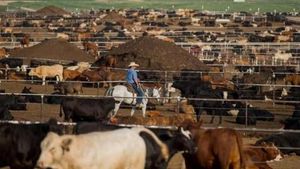Angela Rayner’s abrupt resignation from her dual roles as Deputy Prime Minister and Deputy Labour Leader on September 5, 2025, has set off a political chain reaction, thrusting the Labour Party into a period of uncertainty and fierce internal competition. The fallout from Rayner’s exit—prompted by an independent adviser’s finding that she had breached the ministerial code by underpaying stamp duty on her seaside flat in Hove—has not only left a gap in the highest echelons of government but also reignited long-simmering debates about Labour’s direction and leadership.
Rayner, widely regarded as a future leader and a bridge between Labour’s grassroots and its government, left her party reeling. According to The Guardian, her resignation has triggered a high-stakes internal election for the Deputy Labour Leader position, a role that holds symbolic and practical importance for the party’s identity and strategy. Meanwhile, the Deputy Prime Minister’s seat did not remain vacant for long—David Lammy, the current Justice Secretary, was swiftly elevated to the role in Prime Minister Keir Starmer’s cabinet reshuffle.
But the drama doesn’t end there. As reported by William Hill, the betting markets have already begun to buzz with speculation about Rayner’s successor as Deputy Prime Minister, even though, technically, the new Deputy Labour Leader may not automatically inherit the government post. The early frontrunner in the odds is Wes Streeting, the Health Secretary, at 4/1, followed closely by Home Secretary Yvette Cooper at 9/2. Other notable names include Pat McFadden and John Healey at 6/1, Shabana Mahmood at 7/1, and former Labour leader Ed Miliband and Education Secretary Bridget Phillipson, both at 10/1. “Angela Rayner’s resignation this morning is likely to spark a major reshuffle of Keir Starmer’s cabinet, with her replacement needing to be appointed,” said Lee Phelps, spokesperson for William Hill.
For Labour loyalists and critics alike, the stakes could hardly be higher. Starmer’s government, already under pressure amid a summer of poor polling, now faces the daunting task of uniting a party that seems as divided as ever. A recent YouGov tracker put Starmer’s personal rating at just 24% favourable, with a staggering 68% unfavourable. Within Labour’s own ranks, a Survation poll in August found that 64% of party members believed the party was “heading in the wrong direction,” and Starmer’s net favourability among members had slipped to -9 points. These figures, reported by The Guardian, paint a picture of a party at a crossroads, with its leadership under scrutiny from both within and without.
The process to select Rayner’s successor as Deputy Labour Leader is as rigorous as it is competitive. The party’s National Executive Committee is expected to meet soon to set the timetable and establish the rules for the contest. To stand, a candidate must secure nominations from 20% of Labour MPs—amounting to 80 MPs—and then obtain support from either 5% of local party branches or three party affiliates, at least two of which must be trade unions. Once the nominations are in, Labour members and affiliates will vote in a preferential ballot, ranking candidates in order of preference. The last time Labour held such a contest while in government was in 2007, when Harriet Harman narrowly defeated Alan Johnson following Tony Blair’s resignation and Gordon Brown’s ascent to party leader.
The list of potential candidates is as diverse as it is formidable. Shabana Mahmood, the recently appointed Home Secretary, is seen as a rising star and a trusted Starmer ally, admired for her organizational prowess and role in shaping Labour’s electoral machinery. Ed Miliband, the former party leader and current Energy Secretary, enjoys strong popularity among Labour members, boasting a net rating of +74 in recent cabinet rankings. Emily Thornberry, chair of the foreign affairs select committee, is a veteran MP whose outspoken positions have both ruffled feathers and won praise.
Wes Streeting, the Health Secretary, is a media-savvy operator known for his sharp attacks on political opponents, but his political standing is less robust—he narrowly retained his seat at the general election and holds a modest +9 net favourability among members. Steve Reed, the Housing Secretary, is another Starmer ally, though his popularity within the party is similarly muted. Bridget Phillipson, the Education Secretary, is well-liked by the grassroots, particularly for her advocacy on childcare and equality, and boasts a net favourability of +28. Peter Kyle, the Business Secretary, is considered an effective communicator, especially on issues related to AI, technology, and regional growth, resonating with the party’s centrist wing.
With David Lammy now installed as Deputy Prime Minister, the contest for Deputy Labour Leader takes on added significance. The winner will not necessarily assume the government post, highlighting the complex interplay between party and state roles in Labour’s structure. This separation has prompted some to question whether Labour can maintain cohesion between its grassroots base and its governing leadership—a challenge that has dogged the party through multiple leadership transitions.
Meanwhile, the betting markets remain in flux. As William Hill notes, all bets are void if no Deputy Prime Minister is appointed or elected by the end of the current UK Parliament, underscoring the unpredictable nature of the current political moment. The odds themselves, while a snapshot of public sentiment and insider speculation, are subject to rapid change as new candidates emerge and alliances shift.
For Prime Minister Starmer, the timing could hardly be worse. His promise of a “phase two” reset for his administration now risks being overshadowed by internal party drama and the specter of leadership contests. The party’s left flank, emboldened by Rayner’s legacy, is likely to push for a candidate who will hold ministers to Labour’s core values, while the centrists may seek a steady hand to reassure voters and party members alike.
As the National Executive Committee prepares to set the rules and schedule for the deputy leadership race, Labour’s internal dynamics are on full display. The contest will test not only the ambitions and appeal of the candidates but also Labour’s ability to balance its grassroots activism with the demands of government. With the public and party members watching closely, the outcome could shape the direction of the party—and the country—for years to come.
The next few weeks promise to be pivotal for Labour. With high-profile figures jockeying for position and the party’s future direction in question, the British political landscape is anything but settled. For now, all eyes are on the Labour Party as it navigates one of its most consequential leadership transitions in recent memory.




